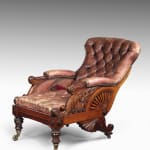Carved Mahogany Reclining Library Chair, Designed by William Smee (1805-1890)
ENGLAND, CIRCA 1850
Height: 40 inches (102cm)
Width: 29.5 inches (75cm)
Depth (upright): 34 inches (86.5cm)
Depth (fully reclined): 68 inches (173cm)
Width: 29.5 inches (75cm)
Depth (upright): 34 inches (86.5cm)
Depth (fully reclined): 68 inches (173cm)
6834
Further images
Boldly-carved acanthus leaf sides, turned lobed front legs and outswept back supports. The reclining action is activated by depressing the mahogany buttons on the arms which releases the ratchets concealed...
Boldly-carved acanthus leaf sides, turned lobed front legs and outswept back supports. The reclining action is activated by depressing the mahogany buttons on the arms which releases the ratchets concealed beneath the arm pads, the pull-out footrest with adjustable upholstered pad. Upholstered to the shaped back and seat in buttoned tan leather with padded leather arms and footrest.
It is likely that a chair of this form was exhibited at the Great Exhibition, London, 1851. The chair’s design is illustrated in the publication: Illustrations of Furniture, Candelabra, Musical Instruments From the Great Exhibitions of London & Paris with Examples of Similar Articles From Royal Palaces and Noble Mansions, John Braund, London, 1858.
One of the earliest designs for a reclining chair was published in a British periodical, Ackermann's Repository of Arts, in 1813. The "Reclining Patent Chair" was a prototype for hundreds of such chairs that were made throughout the century. A drawing of an identical chair appears in the illustration for W. Smee & Sons 1850 (see p. 265 Pictorial Dictionary of British 19th Century Furniture Design, Published by The Antique Collectors Club.)
William Smee (1805-1890) was a London cabinet maker and upholsterer based in Moorfields. The business was referred to as William Smee & Son and later W A Smee & Son(s). By 1890 the firm was known as Smee & Cobbay. They exhibited a walnut and marquetry cabinet at the Great Exhibition of 1851, a finely carved chiffonier in Italian walnut with tulipwood bandings and a birch and tulipwood wardrobe at the London International Exhibition in 1862 and an oak sideboard at the 1878 Paris Exhibition. They supplied West End furnishing shops and provincial furniture makers such as Pratt’s of Bradford.
It is likely that a chair of this form was exhibited at the Great Exhibition, London, 1851. The chair’s design is illustrated in the publication: Illustrations of Furniture, Candelabra, Musical Instruments From the Great Exhibitions of London & Paris with Examples of Similar Articles From Royal Palaces and Noble Mansions, John Braund, London, 1858.
One of the earliest designs for a reclining chair was published in a British periodical, Ackermann's Repository of Arts, in 1813. The "Reclining Patent Chair" was a prototype for hundreds of such chairs that were made throughout the century. A drawing of an identical chair appears in the illustration for W. Smee & Sons 1850 (see p. 265 Pictorial Dictionary of British 19th Century Furniture Design, Published by The Antique Collectors Club.)
William Smee (1805-1890) was a London cabinet maker and upholsterer based in Moorfields. The business was referred to as William Smee & Son and later W A Smee & Son(s). By 1890 the firm was known as Smee & Cobbay. They exhibited a walnut and marquetry cabinet at the Great Exhibition of 1851, a finely carved chiffonier in Italian walnut with tulipwood bandings and a birch and tulipwood wardrobe at the London International Exhibition in 1862 and an oak sideboard at the 1878 Paris Exhibition. They supplied West End furnishing shops and provincial furniture makers such as Pratt’s of Bradford.










